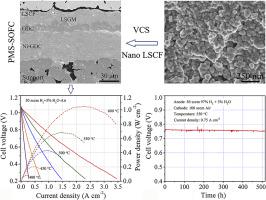Materials Today Energy ( IF 9.0 ) Pub Date : 2021-07-09 , DOI: 10.1016/j.mtener.2021.100815 S.-L. Zhang 1, 2 , Y.-B. Shang 2 , C.-X. Li 2 , C.-J. Li 2

|
Porous metal-supported solid oxide fuel cells (PMS-SOFCs) demonstrate potential to dramatically reduce their costs while simultaneously enhancing the durability of SOFCs. However, owing to the unsatisfactory performance improvement of PMS-SOFCs at low temperatures and available fabrication processes, their commercial applications are limited. In this study, exceptional performance of PMS-SOFCs for electricity generation at low temperatures (400–600 °C) with vacuum cold sprayed (VCS) nanostructured La0.6Sr0.4Co0.2Fe0.8O3−δ (LSCF) as the high-activity cathode, the plasma-sprayed Ce0.8Gd0.2O2−δ/La0.8Sr0.2Ga0.8Mg0.2O3−δ (GDC/LSGM) bilayer as the electrolyte, and a cermet consisting of the nickel–gadolinium-doped-ceria (Ni–GDC) composite as the anode. By carefully controlling the spray particle size, a nanostructured LSCF cathode is obtained, and the oxygen reduction reaction (ORR) is activated. Consequently, the microstructurally optimized cell exhibits remarkable peak power densities of >1 W/cm2 at 600 °C and >0.2 W/cm2 at 450 °C. Moreover, this nanostructured cathode maintains high activity over 1000 h at 550 °C due to the stable microstructure, strontium (Sr) surface segregation, and the exceptional stability of PMS-SOFCs. Our results demonstrate a simple route to dramatically improve the performance and stability of PMS-SOFCs operating at low temperatures by using a nanoscale cathode for activity toward the ORR.
中文翻译:

真空冷喷涂纳米结构 La0.6Sr0.4Co0.2Fe0.8O3-δ 作为多孔金属负载固体氧化物燃料电池的高性能阴极,可在 600 °C 以下运行
多孔金属支撑的固体氧化物燃料电池 (PMS-SOFC) 显示出显着降低成本的潜力,同时提高 SOFC 的耐用性。然而,由于 PMS-SOFCs 在低温和可用的制造工艺下的性能改进不尽如人意,其商业应用受到限制。在这项研究中,采用真空冷喷涂 (VCS) 纳米结构的 La 0.6 Sr 0.4 Co 0.2 Fe 0.8 O 3-δ (LSCF) 作为高-活性阴极,等离子喷涂 Ce 0.8 Gd 0.2 O 2-δ /La 0.8 Sr0.2 Ga 0.8 Mg 0.2 O 3-δ (GDC/LSGM) 双层作为电解质,由镍钆掺杂氧化铈 (Ni-GDC) 复合材料组成的金属陶瓷作为阳极。通过仔细控制喷雾粒径,获得纳米结构的 LSCF 阴极,并激活氧还原反应 (ORR)。因此,微结构优化的电池 在 600°C 时表现出 >1 W/cm 2和 在 450°C 时>0.2 W/cm 2 的显着峰值功率密度。此外,由于稳定的微观结构,这种纳米结构的阴极在 550°C 下保持高活性超过 1000 小时、锶 (Sr) 表面偏析以及 PMS-SOFC 的出色稳定性。我们的结果证明了通过使用纳米级阴极对 ORR 进行活性来显着提高 PMS-SOFC 在低温下运行的性能和稳定性的简单途径。











































 京公网安备 11010802027423号
京公网安备 11010802027423号